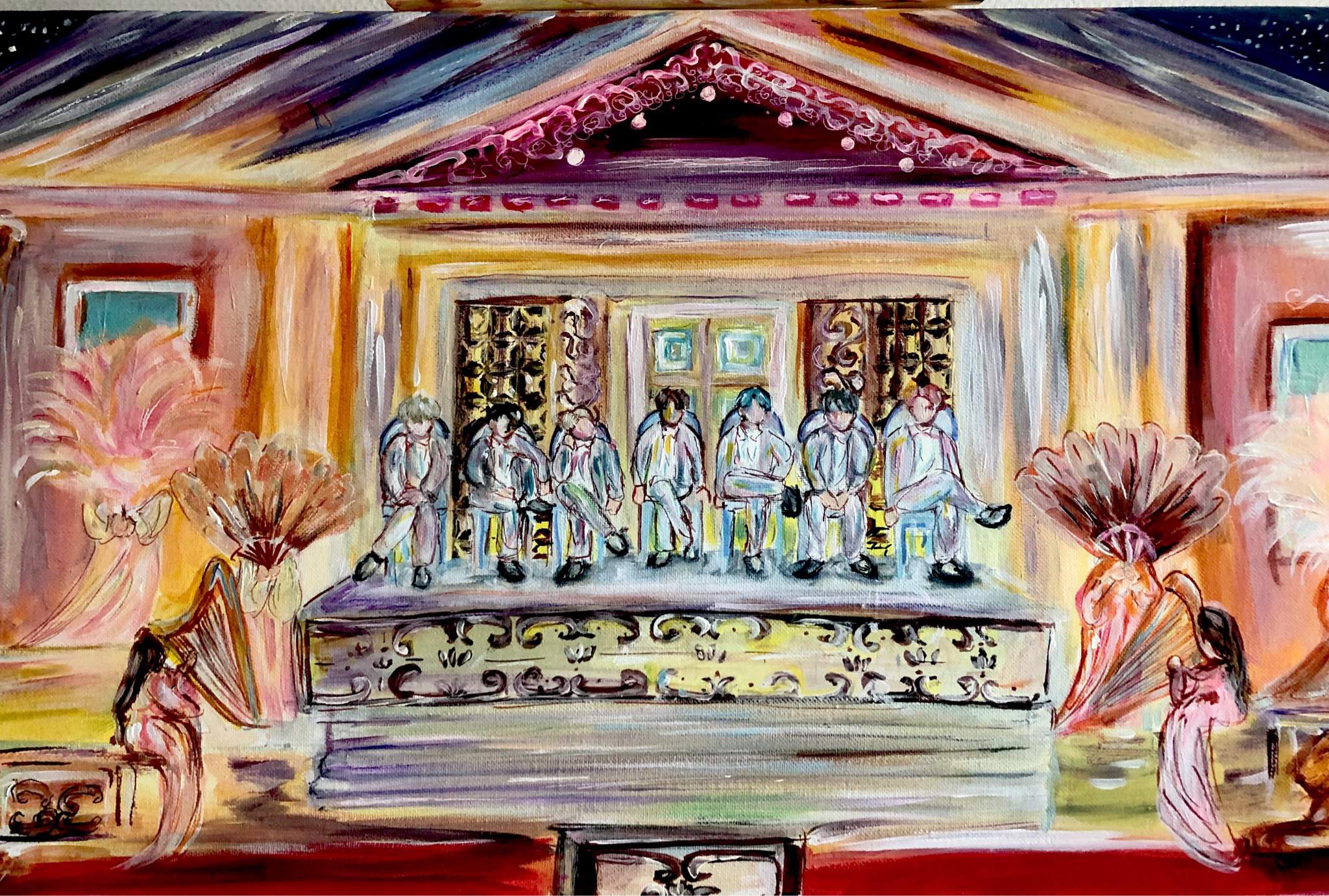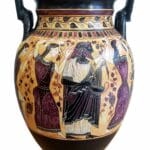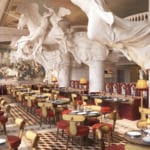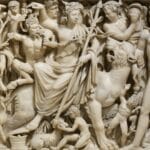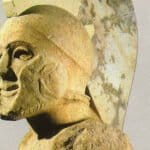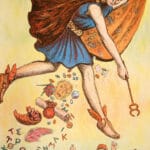The 2024 Paris Olympics opening ceremony ignited a firestorm of debate. A visually stunning tableau, inspired by a 17th-century painting, sparked a conversation about art, religion, and the enduring power of ancient myths in the modern world. At the heart of the controversy lay Dionysus, the god of wine, revelry, and ecstasy, whose legendary feasts have captivated artists for millennia. This article explores the rich history of Dionysian feasts in art, from ancient pottery to Baroque masterpieces, focusing on Jan van Bijlert’s *The Feast of the Gods* and its surprising connection to the Olympic spectacle. We will analyze the painting’s symbolism, compare it to iconic works like Leonardo da Vinci’s *Last Supper*, and delve into the complexities of the ensuing debate.
A Bacchanalian Tapestry Through Time
Jan van Bijlert’s The Feast of the Gods (c. 1635-1640), housed in the Musée Magnin, Dijon, is more than a captivating scene; it’s a microcosm of 17th-century Dutch Baroque artistry. While depicting the mythical wedding of Peleus and Thetis, the painting’s true star is Dionysus. His presence bursts forth, a vibrant counterpoint to the more restrained Olympian deities. Bijlert’s masterful use of light and shadow, his rich palette, and the dynamic energy of the scene perfectly capture the god’s wild spirit. The detail is breathtaking; each figure, each garment, contributes to the overall sense of opulent revelry. This painting serves as a powerful example of the artist’s skill in capturing the essence of a Dionysian celebration.
The 2024 Paris Olympics opening ceremony, under the artistic direction of Thomas Jolly, presented its own interpretation of a Dionysian feast, provoking a passionate response. Was it a joyous celebration of life, a playful homage to Bijlert (and perhaps even Da Vinci’s Last Supper)? Or was it irreverent and insensitive? The ensuing debate highlights art’s power to ignite conversation, even controversy. The striking visual similarities to The Last Supper underscored the profound differences in message: one portraying a sacred Christian event, the other, a pagan bacchanal. This contrast became the crux of the debate, prompting questions about Jolly’s intentions.
Comparing Feasts: A Study in Contrasts
Comparing Jolly’s Olympic spectacle, Bijlert’s painting, and Da Vinci’s Last Supper requires careful consideration. While all depict communal meals, the similarities largely end there. Da Vinci’s painting exudes serenity and solemnity, portraying a sacred ritual. In contrast, Dionysian feasts, as depicted by Bijlert and, arguably, Jolly, are characterized by unrestrained joy, and sometimes chaos—a celebration of earthly pleasure. This stark contrast highlights the chasm between Christian and pagan beliefs, making the Olympic performance’s interpretation particularly significant. It’s plausible that the juxtaposition was deliberate, intended to create a dialogue, though this is far from universally accepted.
The theme of Dionysian feasts transcends the Baroque and modern contexts. From ancient Greek pottery showing ecstatic celebrations to Roman murals depicting joyous processions, the imagery endures. Renaissance artists also drew inspiration from this rich tradition, creating their own interpretations. This enduring appeal stems from Dionysus himself: a god of wine, ecstasy, and transformation. His feasts reflect humanity’s primal yearning for uninhibited celebration and a connection with the untamed forces of nature.
Who Painted the Feast of Dionysus? [https://www.lolaapp.com/who-painted-the-feast-of-dionysus]
The question of who painted a “feast of Dionysus” takes an unexpected turn, encompassing a renowned painting, a spectacular Olympic ceremony, and a considerable debate surrounding artistic inspiration and interpretation. It all begins with Jan van Bijlert’s The Feast of the Gods, a magnificent example of Dutch Golden Age painting (roughly 1635-1640) currently displayed at the Musée Magnin in Dijon, France. It is not a strictly Dionysian bacchanal, but rather the wedding of Peleus and Thetis. However, the scene’s energy, abundance, and revelry evoke a similar atmosphere.
The Olympics and a Striking Resemblance [https://www.lolaapp.com/what-is-the-controversial-painting-at-the-olympics]
The 2024 Paris Olympics opening ceremony featured a remarkably similar scene, triggering a widespread online debate: homage, inspiration, or artistic appropriation? The internet buzzed with opinions from art critics, the Olympics committee, the Musée Magnin, and other artists, highlighting the complex relationship between artistic inspiration and copyright, and underscoring the enduring power of classical myths.
Jan van Bijlert: A Master of the Baroque
Beyond the controversy, van Bijlert’s artistic skill deserves recognition. The Feast of the Gods showcases his mastery of light and shadow, his rich color palette, and his meticulous detail. As a member of the Utrecht Caravaggisti, his style is characterized by dramatic chiaroscuro and realistic portrayals, evident in the opulence and dynamism of his work.
Unpacking the Symbolism [https://www.lolaapp.com/what-is-the-controversial-painting-at-the-olympics]
Van Bijlert’s painting transcends mere aesthetics; it’s a complex visual narrative. Every detail — the arrangement of figures, their attire, even the background setting — is laden with symbolic meaning. While Apollo holds a central position, the presence of other figures, potentially alluding to Dionysus, adds to the painting’s enigmatic quality. The work invites viewers to actively engage with its multiple layers of meaning, making it a source of ongoing scholarly discussion and fascination.
Beyond the Simple Question
The question “Who painted the feast of Dionysus?” and the subsequent Olympic controversy exemplifies the multifaceted nature of art-related discussions. It reveals the continued relevance of classical mythology in modern art and its ability to inspire both new creations and public discourse. The controversy, likely to persist, highlights the ongoing debate surrounding artistic influences, inspiration, and the legal complexities of artistic appropriation. Further research may uncover yet more hidden meanings within the painting.
The Paris Olympics Controversy: A Deeper Dive [https://www.lolaapp.com/what-is-the-controversial-painting-at-the-olympics]
The 2024 Paris Olympics opening ceremony sparked significant debate over a performance piece that many viewed as a disrespectful reimagining of Leonardo da Vinci’s Last Supper. However, the intention, and the ultimate meaning, remain hotly debated.
A Feast for the Gods – and a Public Outcry
The controversy centered on a tableau depicting a lively feast, strikingly reminiscent of The Last Supper, yet distinctly different. The inspiration was clearly Bijlert’s Le Festin des Dieux. The Olympic performance mirrored the painting’s composition but with a crucial twist: a diverse cast, including LGBTQ+ performers, enacting the roles of gods. This substitution, combined with the visual echo of The Last Supper, created a clash between artistic expression and religious sensitivities. The collision between pagan revelry and deeply held Christian beliefs fueled the conflict.
Artistic Vision vs. Public Outrage: Two Sides of the Same Coin
The organizers’ intention was to celebrate diversity and evoke the spirit of Dionysus. However, for many, the visual similarity to The Last Supper overshadowed this intent. Was it a deliberate act of provocation? An unintended homage? Or a mere coincidence? The diverse reactions underscore the challenges of communication in a large public event and the subjective nature of artistic interpretation.
Stepping Back in Time: Historical Context
Before judging the Olympic performance, considering Le Festin des Dieux is crucial. Bijlert’s painting radiates energy— vibrant movement, rich colors, and dramatic chiaroscuro. The gods are depicted with remarkable dynamism, a marked contrast to the quiet solemnity of Da Vinci’s work. Considering Dionysian imagery across history, from ancient Greek pottery to Roman murals and Renaissance paintings, reveals a long tradition of diverse symbolism and interpretation, spanning millennia and cultures.
Differing Perspectives, Unanimous Engagement
The comparison to The Last Supper understandably offended some Christians. The inclusion of drag performers further intensified this negative reaction for many. Conversely, others celebrated the performance as a progressive act of inclusivity and diversity, aligning it with Dionysus’s spirit of uninhibited joy. The controversy thus became a lens through which to view ongoing debates about religious representation, LGBTQ+ visibility, and artistic freedom.
The Musée Magnin’s Role
The Musée Magnin’s public confirmation of the painting’s role as inspiration helped clarify matters, though it didn’t entirely quell the debate.
Lessons Learned
This event raises crucial questions about artistic freedom, public reception, and the challenges of cross-cultural communication. It’s a potent reminder of the subjective nature of artistic interpretation and the necessity of understanding context before judgment. Ongoing discussions within art history, religious studies, and social commentary will likely continue to shape our understanding of this event for years to come.
What is the Feast of Dionysus About? [https://www.lolaapp.com/what-is-the-feast-of-dionysus-about]
Dionysus, the Greek god of wine, theatre, and fertility, presided over festivals that transcended mere revelry; they were deeply symbolic rituals exploring themes of rebirth, release, and humanity’s bond with nature. These were not mere frat parties, but profoundly meaningful celebrations.
Diverse Celebrations, Unifying Themes
The City Dionysia, a major Athenian spring event, featured dramatic competitions, parades, and communal celebrations, a massive civic festival. The rural Dionysia, in contrast, were more spontaneous affairs, focusing on harvest celebrations and expressing a more direct connection to nature. The Anthesteria, honoring ancestors, and the Lenaia, a winter artistic celebration, further enriched this varied Dionysian calendar.
Deciphering the Symbols
Recurring symbols, such as the thyrsus (a staff topped with a pine cone, representing fertility and ecstasy), masks (enabling role-playing and shedding of everyday identities), and the Maenads (female followers whose wild dances embodied untamed feminine energy or sheer abandon), layered meaning and continue to spark scholarly debate.
The Paris Olympics and the Ongoing Discussion
The 2024 Paris Olympics controversy highlighted the enduring power of these ancient images. The tableau, supposedly inspired by The Feast of the Gods, sparked intense debate, particularly due to its perceived similarity to the Last Supper. Was this a conscious contrast? A playful subversion of religious themes? The lasting impact of this event is the ongoing conversation it sparked regarding artistic intention and audience interpretation.
A Timeless Legacy
Dionysus’s influence persists. Artists, writers, and even psychologists continue to draw inspiration from his mythology. The themes of creativity, chaos, and intense emotion remain resonant. Dionysus’s festivals serve as potent reminders of the importance of ritual in community building, emotional processing, and the exploration of the human condition. Whether interpreted in ancient pottery or a modern Olympic performance, Dionysian imagery continues to provoke thought and inspire conversation.
(Include your table summarizing key differences here, as previously provided.)
Further research into the evolving interpretations of Dionysian imagery across different historical periods and cultural contexts is crucial for a comprehensive understanding of its enduring appeal. While we’ve explored some key interpretations, detailed analysis of specific artistic choices and their symbolic significance within their broader religious and cultural contexts offers promising avenues for future study. There’s much more to uncover about the continued relevance and evolving interpretations of Dionysian imagery.
- Unlock Filipino Culture: A Deep Dive into Traditions and Practices - April 23, 2025
- Unlock Spanish Culture: Insights & Opportunities Now - April 23, 2025
- White Spirit Uses & Substitutes: A Deep Dive for Pros & DIYers - April 23, 2025
